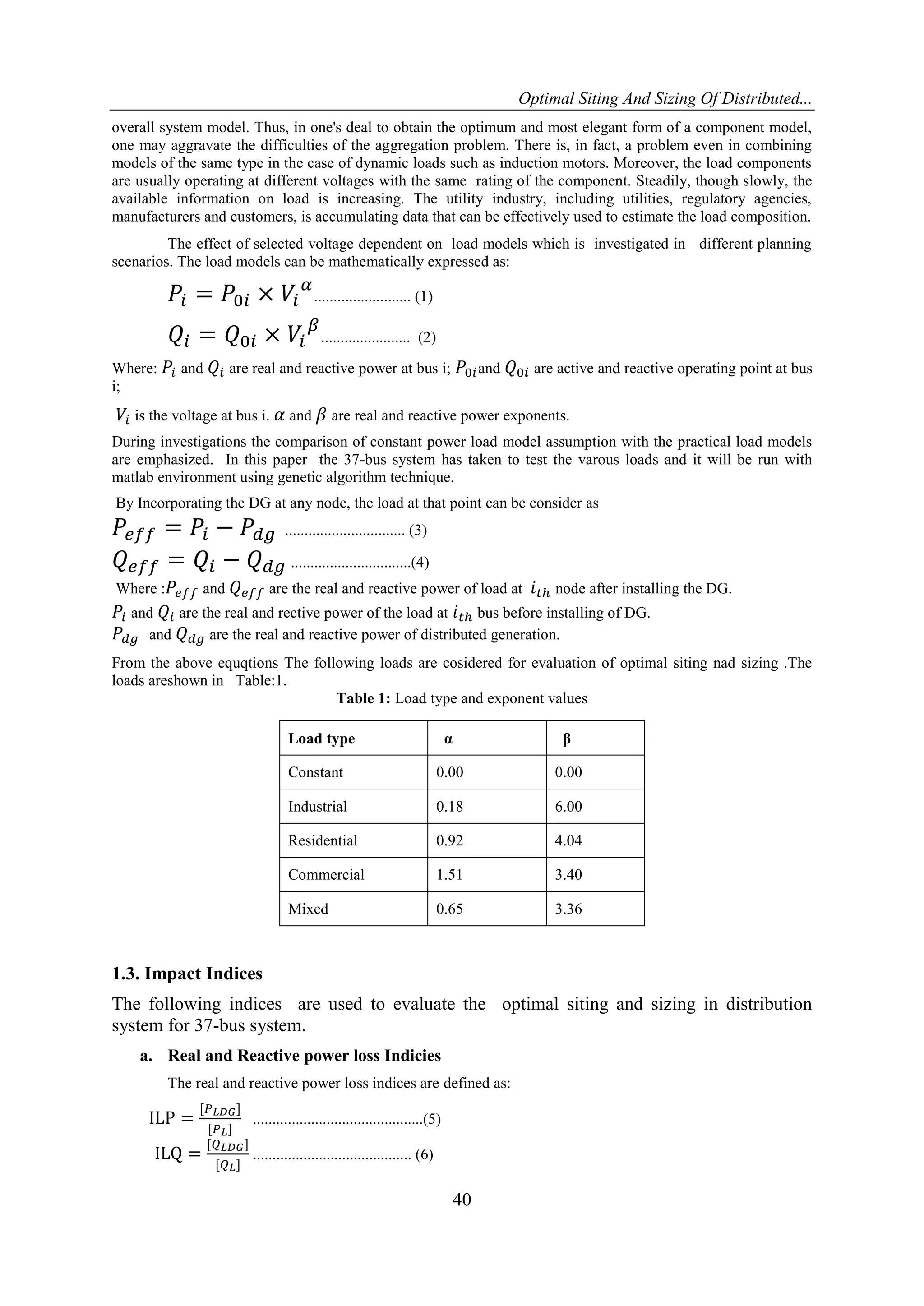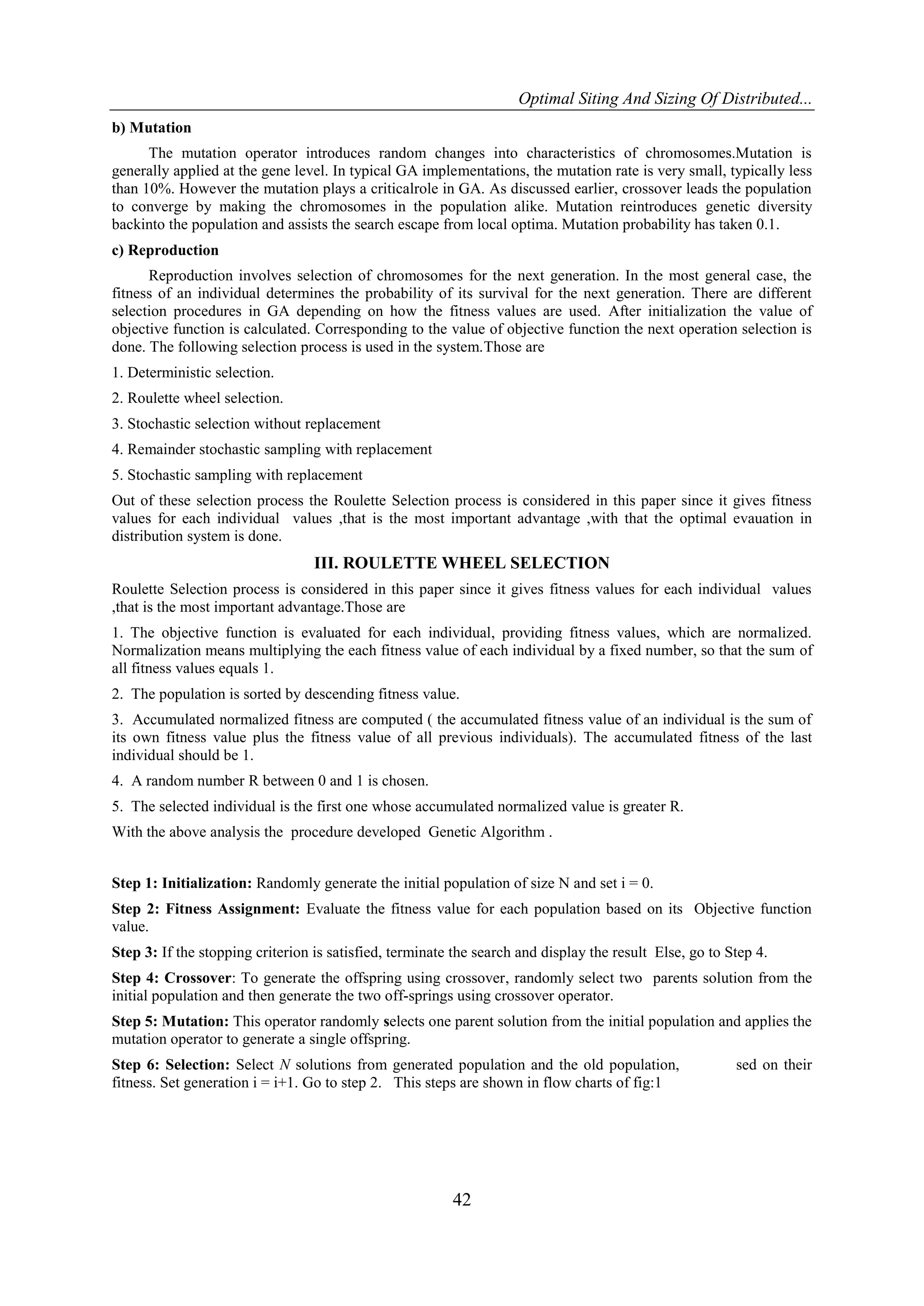This document discusses optimal siting and sizing of distributed generation (DG) in radial distribution systems using a genetic algorithm. It evaluates the performance through a multi-objective index and various load models, focusing on economic and technical benefits such as reduced line losses and improved voltage profiles. The results are demonstrated using a 37-bus test system to optimize the positioning and capacity of DG installations.
![Research Inventy: International Journal Of Engineering And Science
Vol.5, Issue 4 (April 2015), PP 39-46
Issn (e): 2278-4721, Issn (p):2319-6483, www.researchinventy.com
39
Optimal Siting And Sizing Of Distributed Generation For Radial
Distribution System Using Genetic Algorithm
N.Vijaysimha1
,Ch.Chengaiah2
,M.VenuGopal3
1
Research Scholar, Departments of EEE, K.LUniversity, Guntur, A.P., INDIA.
2
Assosciate proffesor,Department of EEE,S.V.University,Tirupati.A.P,INDIA,
3
Head & Professor, Department of EEE, K.L. University, Guntur, A.P,INDIA,
Abstract: Distributed generation (DG) is an emerging concept in the electricity sector, which represents good
alternatives for electricity supply instead of the traditional centralized power generation concept.This paper
presents a multi-objective performance index –based size and site determination of distributed generations in
distribution system with various load models. The Optimal size and site of distributed generation is evaluated
with multi-objective optimized values.The Multi-objective index is converted into Single objective performance
index with the help of significant weights. It can evaluated the optimal siting and sizing with Genetic Algorithm
(GA) and resluts were tested with 37-bus radial distribution system
Keywords – Distributed Generation (DG), Genetic Algorithm (GA), load model, Multi-Objective Index.
I. INTRODUCTION
The distributed generation [1] is used to refer to generation units that are connected to the distribution network
rather than to the high voltage transmission grid. The renewed popularity of Disribution Generator (DG) after a
period of hiatus is creating new opportunities for increasing the diversity and efficiency of our electricity supply
and It is also challenging the established architecture of the networks.
Since the past years the generation at large scale took place at near fuel center which is far away for the
load centers in case of nuclear also.These made intiation of DG is encouraged as part of the government’s
lowcarbon energy policy aimed at reducing the emissions linked to climate change.
The distributed real power sources can be classified into two categories [4] as Type-1-DG and Type-2-
DG.Where Type-1-DG are supply the real power, depending on the availability or demand, to the network
without demanding any reactive power. The best examples of Type-1-DG are photovoltaic cell, fuel cell, battery
storage. Which are modeled as negative real power loads in the load flow analysis and Type-2-DG are supply
the real power to the network only when adequate reactive power support is provided by the network or any
local reactive power sources.DG can be installed at load or near the load.In this paper the DG considered at load
point only. By using this DG in distribution System,the following economic and technical benefits are being
implicated .
The major technical benefits are:
Reduced line losses
Voltage profile improvement
Reduced emissions of pollutants
Increased overall energy efficiency
Enhanced system reliability and security
1.2. Load Model:
Normally loads are assumed to b real power and reactive power and is called constant power .In this paper not
only the constant loads but industrial load, residential load, commercial load and mixed load are conisdered.The
studies of dynamic performance, load representation becomes more important.The Load characteristics affect
the dynamic behavior of a power system.The exact composition of the load is often very difficult to estimate.
Load composition changes continually reflecting the customers' pattern of using various appliances and devices.
It depends on the customers' lifestyle, the weather, the state of economy, and many other factors. It is important
to estimate the load composition at time of critical interest such as under a heavy or light load condition. As load
demand is increasing day to day life still it is necessary for a reliable estimation of load composition. Even if
the load composition is known exactly, it would be impractical to represent each individual load component, as
there are usually many thousands of components. Generally the model of the composite load will be
impractically complex and will require considerable mathematical processing to obtain a reasonably manageable](https://image.slidesharecdn.com/f054039046-150518095230-lva1-app6891/75/Optimal-Siting-And-Sizing-Of-Distributed-Generation-For-Radial-Distribution-System-Using-Genetic-Algorithm-1-2048.jpg)



![Optimal Siting And Sizing Of Distributed...
43
Fig. 1 Flow chart for Genetic Algorithm
IV. TEST OF 37-BUS SYSTEM USING GENETIC ALGORITHM (GA)
The 37-bus test system are taken from[7] the base values used are 100 MVAand 23 kV. The exhaustive power
flow solution for the37-bus distribution system is obtained in the following fashion.With this the system is
tested at different power factors such as upf,0.8laging and 0.8 leading by considering single DG
optimization,two DG,three DG,four DG and five DG optimization are tested with MATLAB environment using
Genetic Algorithm Technique and corressponding test results for optimization of objective function is discussed
elabrately in the following cases
Case 1.
a. Single DG Optimization for UPF:
The population size is 20. The chromosome length is 15. The first five bit of chromosome contains only 0 or 1.
The bit 0 represents that there is no DG and the bit 1 represents there is a DG at the corresponding place. The
next five bit represents the number of node and the last five bit represents the size of the DG. After initialization
of the population and calculating the fitness function the selection, crossover and mutation is done. And the
obtained optimal site and size is as following for all the five type of loads.](https://image.slidesharecdn.com/f054039046-150518095230-lva1-app6891/75/Optimal-Siting-And-Sizing-Of-Distributed-Generation-For-Radial-Distribution-System-Using-Genetic-Algorithm-5-2048.jpg)

![Optimal Siting And Sizing Of Distributed...
45
From the above analysisl, a DG size is considered in a practical range (0–0.63 p.u.). The DG of 0.0 p.u.
corresponds to system without DG whereas 0.63 p.u. corresponds to a case of maximum possible value of DG
planned. First it is considered that the DG is operated at unity p.f. and then 0.8 power factor lagging and
leading. And for two DGs, three DGs,and four DGs has been evaluated and from table2 ,table3 the optimal site
and size are inversely propotional ,it means if more than one DG the cost will become more and the aytem is
also more complex i.e.it is better to install the single DG of single DG of lagging power factor (p.f=0.8) is better
but in the case of leading power factor DG (p.f=0.8) the value of IMO increases. Finally the comparison
between single and multi objective optimizations are
(1) In general, multi-objective optimization requires more computational effort than single-objective
optimization. Unless preferences are irrelevant or completely understood, solution of several single-objective
problems may be necessary to obtain an acceptable final solution.
(2) The advantage of the weighted sum approach is a straightforward implementation. Since a single objective is
used in fitness assignment, a single objective GA can be used with minimum modifications.Amulti-objective
GA based set of solutions have difficulty in finding the single solution.
(3) Solutions obtained with no articulation of preferences are arbitrary relative to the Pareto optimal set. In this
class of methods, the objective sum method is one of the most computationally efficient, easy-to-use, and
common approaches. Consequently, it provides a benchmark approach to multiobjective optimization.
4) Solution obtained by single objective optimization is unique which is globally optimized and user is bound to
go for that solution only but in case of multi-objective optimization user is free to choose the solution as per his
requirement.
V. CONCLUSION
The exhaustive analysis, including load models, for size-location planning of distributed generation in
multiobjective optimization in distribution systems is presented. The multiobjective criteria based on system
performance indices of ILP and ILQ, related to real and reactive power losses, and IC and IVD, related to
system MVA capacity enhancement and voltage profile improvement, is utilized in the present work. The
overall value of multiobjective index (IMO) is found to be significantly different with different load models.
The effect of load models on individual performance indices is also shown and it is established that the load
models play a decisive role in deciding the size-location pair of DG in any practical distribution system. The
application of GA for DG size-location planning has been tested by comparing the results with exhaustive
enumeration. It was observed that when GA was run multiple numbers of times at some cases the suboptimal
solutions were also obtained. It is worth noting that, no cases is cosidered the suboptimal solution compared to
second best solution of suboptimal values.Finally the solution for the small could be obtained in the exhaustive
fashion but it becomes prohibitive for large system and therefore GA is useful for such system even with
suboptimal solutions.
REFERENCES
[1]. Decoupled Solution of Radial and Weakly Meshed Distribution Networks Through aBackward
Method, ”Antonino Augugliaro, Luigi Dusonchet, Salvatore Favuzza, Mariano G.Ippolito, Stefano
Mangione,and Eleonora Riva Sanseverino”.
[2]. Distribution System Load Flow using Object-Oriented Methodology, M.P.Selvan, StudentMember,
IEEE, and K.S.Swarup, Senior Member, IEEE.
[3]. 3 C. Concordia and S. Ihara, “Load representation in power systems stability studies,” IEEETrans.
Power App. Syst., vol. PAS-101, no. 4, pp. 969–977, Apr. 1982.
[4]. IEEE Task Force on Load Representation for Dynamic Performance, “Bibliography on loadmodels for
power flow and dynamic performance simulation,” IEEE Trans. Power Syst., vol. 10,no. 1, pp. 523–
538, Feb. 1995.
[5]. IEEE Task Force on Load Representation for Dynamic Performance, “Load representation for dynamic
performance analysis,” IEEE Trans. Power Syst., vol. 8, no. 2, pp. 472–482, May 1993.
[6]. “Multiobjective Optimization for DG Planning With Load Models” Deependra Singh,Devender Singh,
and K. S. Verma.” IEEE transactions on power systems, vol. 24, no. 1, february 2009”
[7]. Using Genetic Algorithm for Distributed Generation Allocation to Reduce Losses andImprove Voltage
Profile” proceedings of world academy of science,engineering and technology volume 27 february
2008 issn 1307-6884”
[8]. S. A. Papathanassion, “A technical evaluation framework for the connection of DG to thedistribution
network,” Electric power systems research. 77, pp. 24 – 34, 2007.
[9]. W. El-Khattam, and M.M.A. Salama, “Distributed generation technologies, definitions and benefits”,
Electric Power Systems Research. 71, pp.119–128, 2004.](https://image.slidesharecdn.com/f054039046-150518095230-lva1-app6891/75/Optimal-Siting-And-Sizing-Of-Distributed-Generation-For-Radial-Distribution-System-Using-Genetic-Algorithm-7-2048.jpg)
![Optimal Siting And Sizing Of Distributed...
46
[10]. Optimal DG Placement in Distribution systems Using Cost/Worth Analysis.”proceedings of world
academy of science, engineering andtechnology volume 37 january 2009 issn 2070-3740.”
[11]. N. Srinivas and K. Deb, “Multiobjective optimization using non-dominated sorting in
geneticalgorithms,” Technical report, Department of Mechanical Engineering, Indian Institute
ofTechnology, Kanpur, India, 1993.
[12]. Deb K, Pratap A, Agarwal S, Meyarivan T. A fast and elitist multiobjective genetic algorithm: NSGA-
II. IEEE Trans Evol Comput 2002;6(2):182–97.
[13]. Deb K, Agrawal S, Pratap A, Meyarivan T. A fast elitist non-dominated sorting geneticalgorithm for
multi-objective optimization: NSGA-II. In: Proceedings of sixth internationalconference on parallel
problem solving from nature, 18–20 September, 2000. Paris, France:Springer; 2000.
[14]. E. Zitzler, K. Deb and L. Thiele, “Comparison of multiobjective evolutionary algorithms: Empirical
results”, Evolutionary Computation, vol.8, pp. 173-195, 2000.
[15]. H. Ishibuchi and T. Murata, “A Multi-Objective Genetic Local Search Algorithm and its Application to
Flowshop Scheduling”, International Conference on Systems, Man, and Cybernetics, vol. 28, pp. 392-
403, 1998.
[16]. T. Murata and H. Ishibuchi, “MOGA: Multi-Objective Genetic Algorithms,” IEEE International
Conference on Evolutionary Computation, vol. 1, pp. 289, 1995.
[17]. K. Deb, “Multiobjective Optimization using Evolutionary Algorithms”, Wiley-Interscience Series in
Systems and Optimization, John Wiley & Sons, 2001.
[18]. Book: Getting started with MATLAB -7 by Rudra Pratap.
[19]. Book: Genetic algorithm in search, optimization and machine learning by David E. Goldberg
List of symbols:
ILP- Real power loss index
ILQ-Reactive power loss index
IC-MVA Capacity index
IVD- Voltage profile index
IMO- Index of multi-objective
VD-Voltage deviation
-Weight given to ILP
-Weight given to ILQ
-Weight given to IC
-Weight given to IVD](https://image.slidesharecdn.com/f054039046-150518095230-lva1-app6891/75/Optimal-Siting-And-Sizing-Of-Distributed-Generation-For-Radial-Distribution-System-Using-Genetic-Algorithm-8-2048.jpg)